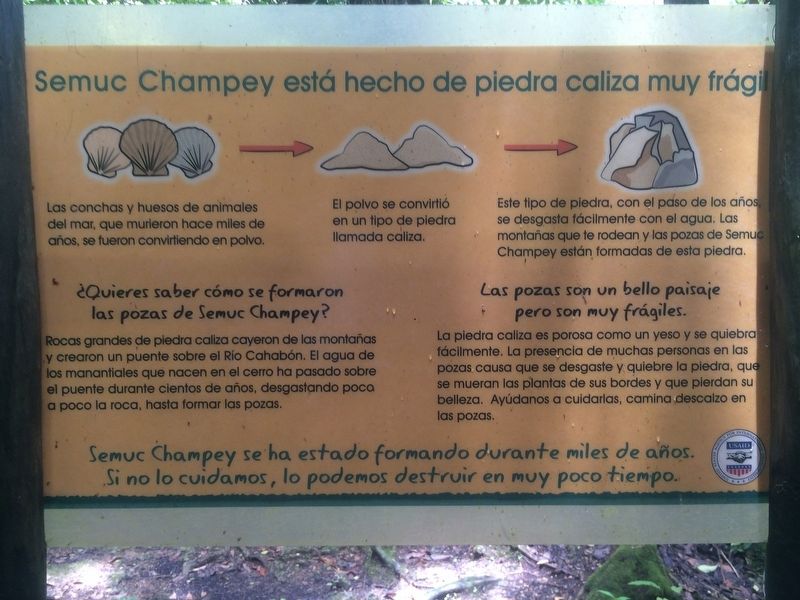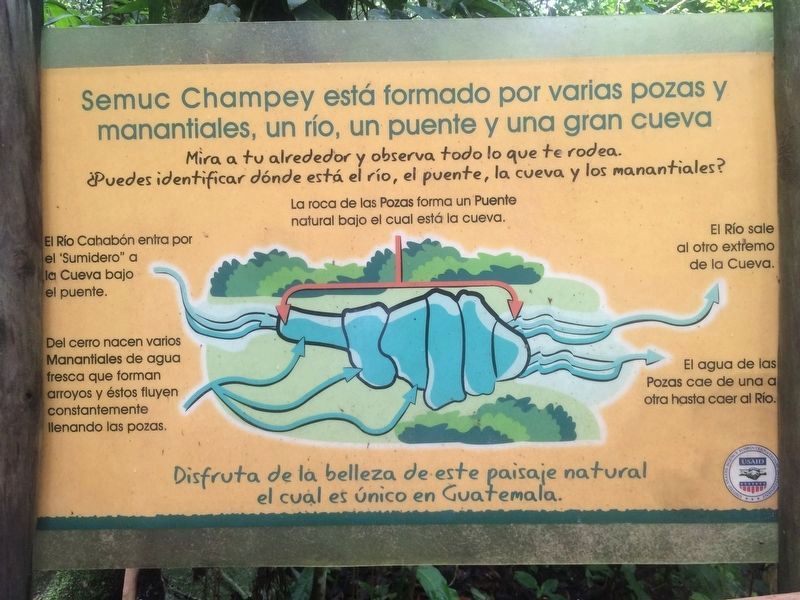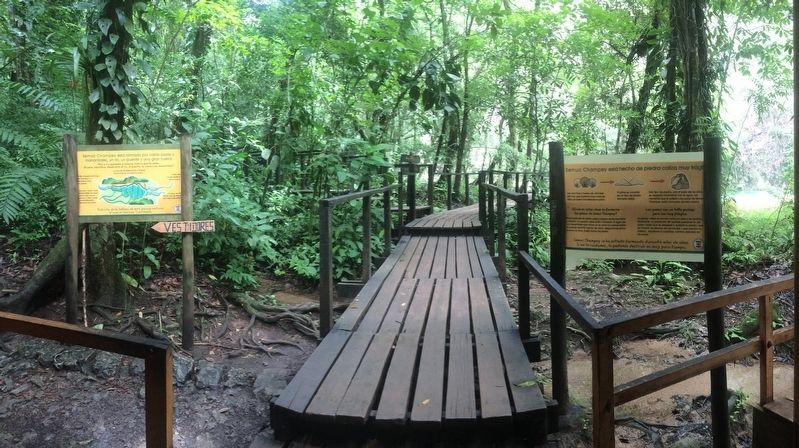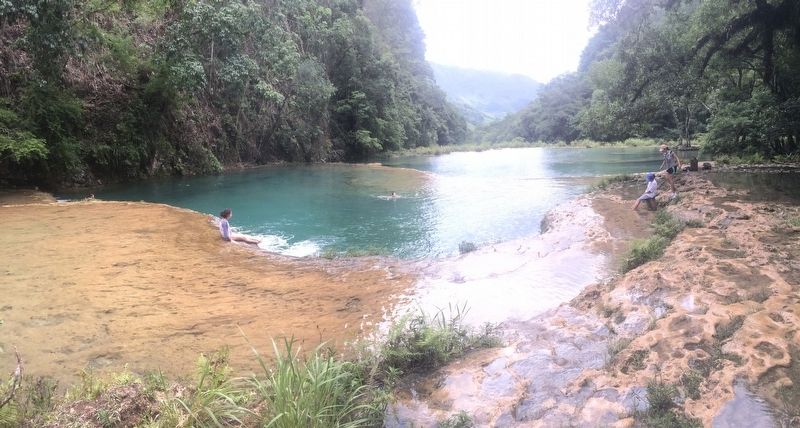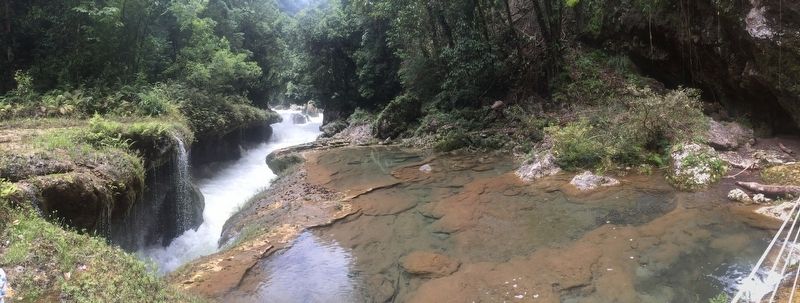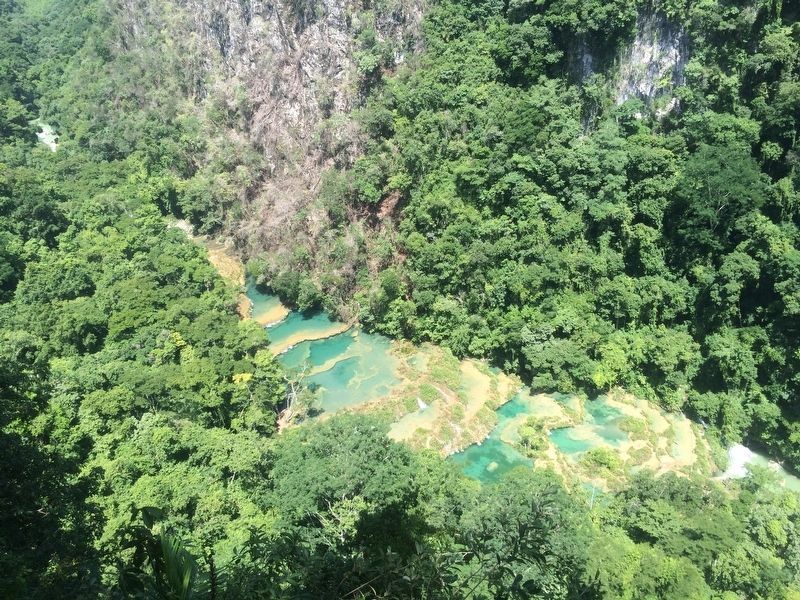Lanquín, Alta Verapaz, Guatemala — Central America
Semuc Champey Pools
Semuc Champey está hecho de piedra caliza muy frágil
Las conchas y huesos de animales del mar, que murieron hace miles de años, se fueron convirtiendo en polvo. El polvo se convirtió en un tipo de piedra llamada caliza. Este tipo de piedra, con el paso de los años se desgasta fácilmente con el agua. Las montañas que te rodean y las pozas de Semuc Champey están formadas de esta piedra.
¿Quieres saber cómo se formaron las pozas de Semuc Champey?
Rocas grandes de piedra caliza cayeron de las montañas y crearon un puente sobre el Río Cahabón. El agua de las manantiales que nacen en el cerro ha pasado sobre el puente durante cientos de años, desgastando poco a poco la roca, hasta formar las pozas.
Las pozas son un bello paisaje pero son muy frágiles.
La piedra caliza es porosa como un yeso y se quiebra fácilmente. La presencia de muchas personas en las pozas causa que se desgaste y quiebra la piedra, que se mueran las plantas de su bordes y que pierdan su belleza. Ayúdanos a cuidarlas, camina descalzo en las pozas.
Semuc Champey se ha estado formando durante miles de años. Si no lo cuidamos, lo podemos destruir en muy poco tiempo.
Otro marcador cercano:
Semuc Champey está formado por varias pozas y manantiales, un río, un puente y una gran cueva
Mira a tu alrededor y observa todo lo que te rodea.
¿Puedes identificar dónde está el río, el puente, la cueva y los manantiales?
El Río Cahabón entra por el “Sumidero” a la Cueva bajo el puente. Del cerro nacen varios Manantiales de agua fresca que forman arroyos y éstos fluyen constantemente llenando las pozas. La Roca de las Pozas forma un Puente natural bajo el cual está la cueva. El Río sale al otro extremo de la Cueva. El agua de las Pozas cae de una a otra hasta caer al Río.
Disfruta de la belleza de este paisaje natural el cual es único en Guatemala.
Semuc Champey is made of very fragile limestone
Shells and the bones of sea animals, who died thousands of years ago, slowly turned into a type of dust. This dust eventually became a type of rock called limestone. This type of stone, over the years, is easily worn with the action of moving water. The mountains around you and the Semuc Champey pools are made of this stone.
Want to know how the Semuc Champey pools formed?
Large limestone rocks fell from the mountains and created a bridge over the Cahabón River. The water from the springs that
start on the hill above the pool has passed over that bridge for hundreds of years, wearing down the rock to form the pools.
The pools are a beautiful landscape but they are very fragile.
Limestone is porous like a plaster and breaks easily. The presence of many people in the pools wears down and breaks the stone. The plants around its edges can die and lose their beauty. Help us take care, walk barefoot while in the pools.
Semuc Champey has taken thousands of years to form. If we are not careful, we can destroy it in a very short time.
An additional, nearby marker:
Semuc Champey consists of several pools and springs, a river, a bridge and a large cave
Look around and see everything that surrounds you.
Can you identify where the river, the bridge, the cave and the springs are located?
The Cahabón River enters "The Drain" where it enters the cave under the natural bridge. From the nearby hills are several springs of fresh water that are constantly flowing and filling these pools. The Rock of the Pools forms a natural bridge beneath which is the cave. The river comes out the other end of the cave. Water from the pools falls from one pool to another and finally falls back into the river.
Enjoy the beauty of this natural landscape which is unique to Guatemala.
Erected by
United States Agency for International Development.
Topics. This historical marker is listed in this topic list: Notable Places.
Location. 15° 32.032′ N, 89° 57.566′ W. Marker is in Lanquín, Alta Verapaz. The marker is near the changing rooms at Semuc Champey National Monument some 8 kms south of Lanquín, Alta Verapaz. Touch for map. Marker is in this post office area: Lanquín, Alta Verapaz 16011, Guatemala. Touch for directions.
Credits. This page was last revised on March 2, 2018. It was originally submitted on October 31, 2016, by J. Makali Bruton of Accra, Ghana. This page has been viewed 473 times since then and 45 times this year. Photos: 1, 2, 3, 4, 5, 6. submitted on October 31, 2016, by J. Makali Bruton of Accra, Ghana.
